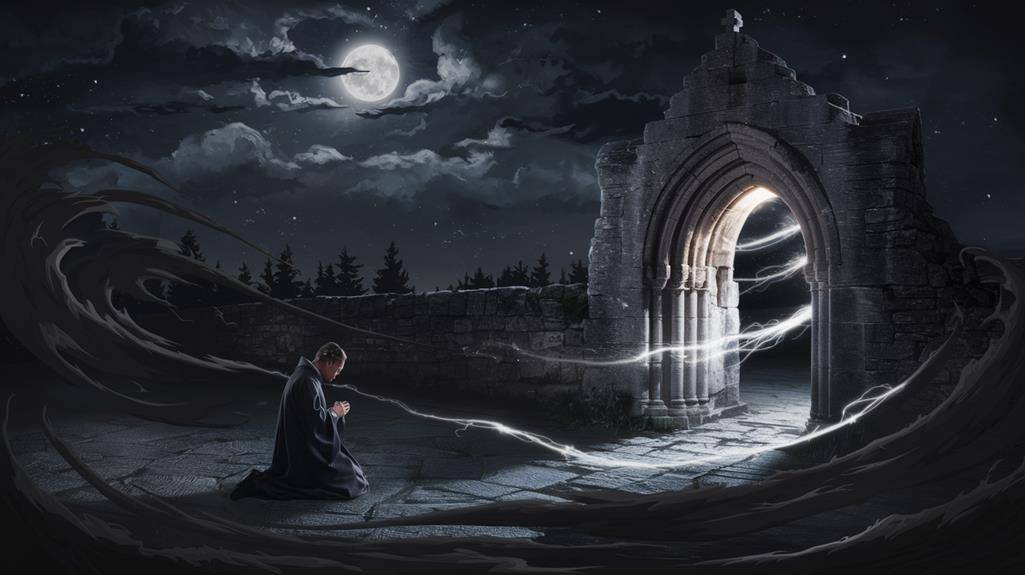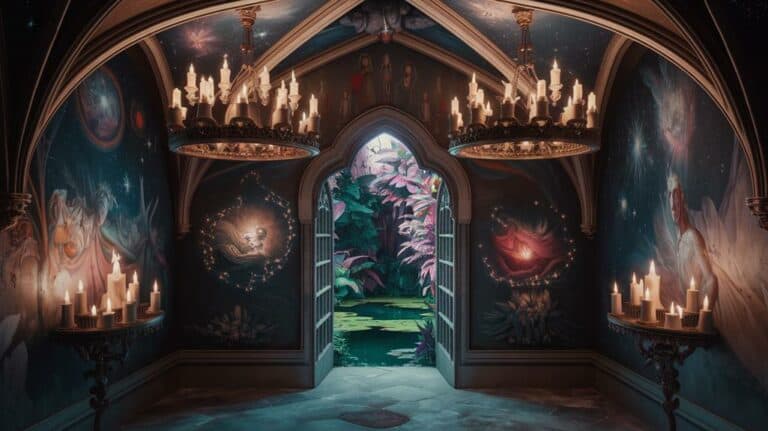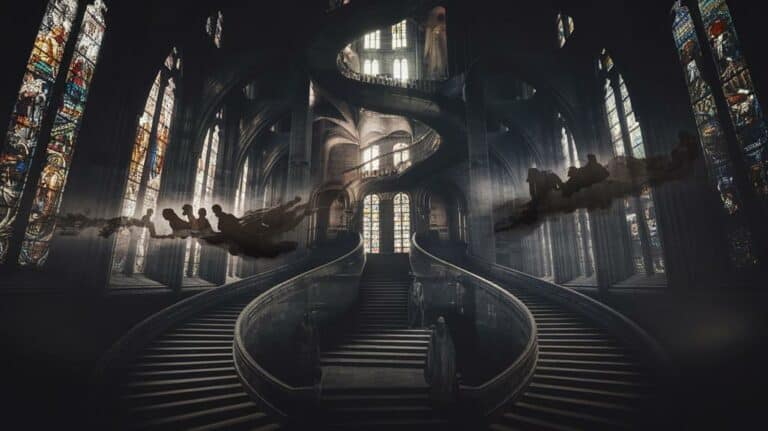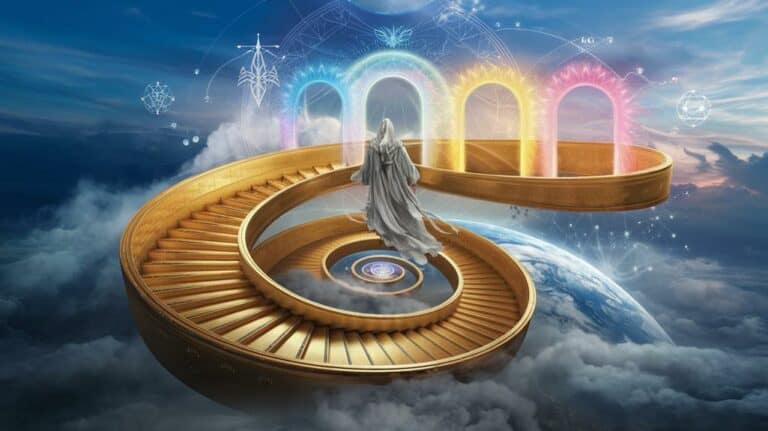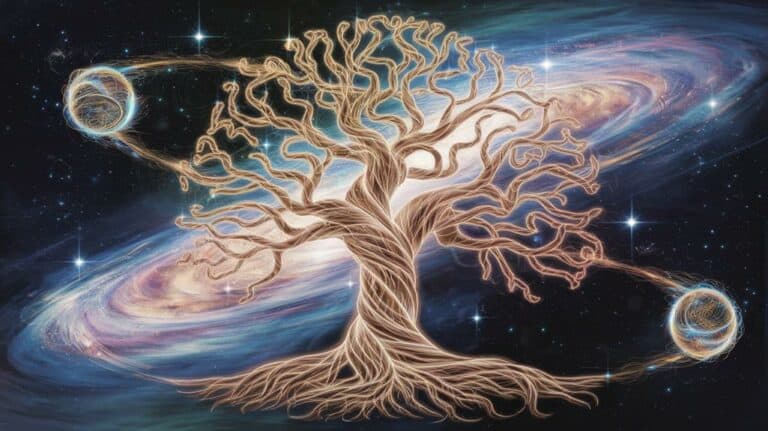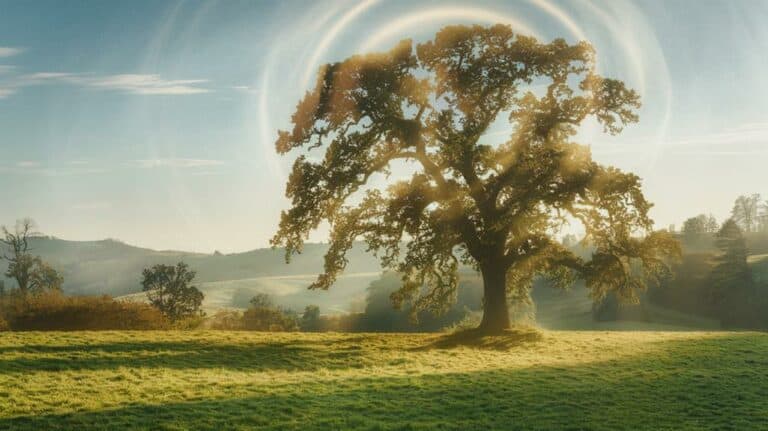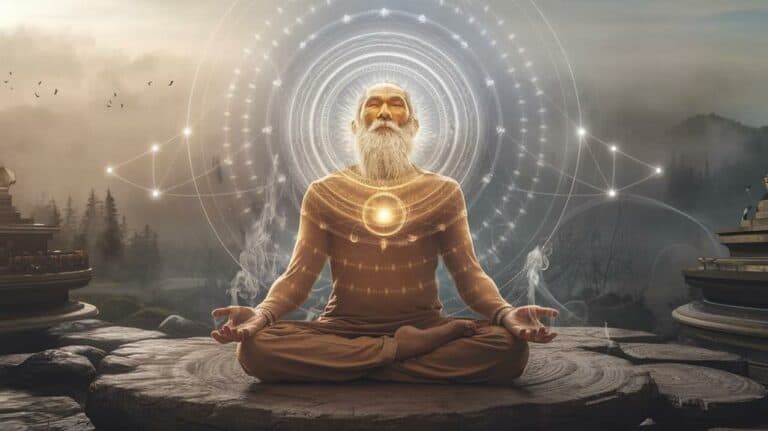The Concept of the “Dark Night of the Soul” in Mysticism
You’ve likely encountered moments when your spiritual compass seems broken, leaving you adrift in a sea of doubt and disconnection. This experience, known as the “Dark Night of the Soul,” isn’t just a modern phenomenon of existential crisis—it’s a profound spiritual concept that’s echoed through centuries of mystical traditions. While you might view these periods of spiritual desolation as something to avoid, mystics and spiritual teachers have long recognized them as essential gateways to deeper awakening. Understanding this paradoxical journey can transform your perception of spiritual darkness from an enemy to be feared into a guide to be embraced.
Historical Origins and Religious Context
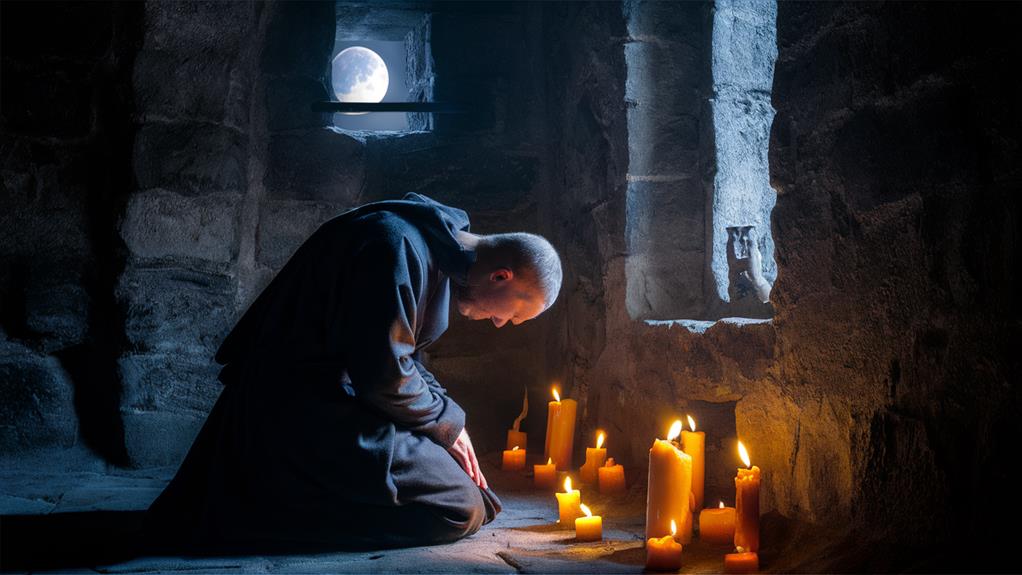
While the term “Dark Night of the Soul” comes from a 16th-century poem by Spanish mystic Saint John of the Cross, the spiritual concept it describes dates back to early Christian monasticism.
You’ll find its earliest expressions in the writings of desert fathers and mothers who retreated to Egypt’s wilderness in the 3rd and 4th centuries, seeking profound spiritual transformation through isolation and contemplation.
Before Saint John’s crystallization of the concept, you’d discover similar themes in medieval mystical works, including those of Julian of Norwich and Meister Eckhart.
They’ve described periods of spiritual desolation as necessary stages in the soul’s journey toward divine union.
The concept isn’t limited to Christianity – you’ll encounter parallel ideas in Sufism’s state of qabd (spiritual constriction) and Buddhism’s concept of the Great Doubt.
When you explore these historical roots, you’ll notice how the dark night transcends religious boundaries, appearing wherever seekers have ventured into the depths of spiritual experience.
It’s emerged across traditions as a universal pattern of spiritual development, where profound disconnection paradoxically leads to deeper connection.
Signs and Stages
The experience of the Dark Night of the Soul manifests through distinct signs and unfolds in recognizable stages, much like the universal patterns observed across religious traditions.
You’ll notice your once-vibrant spiritual practices feel hollow, and previously meaningful rituals may lose their resonance. Your inner landscape transforms into a wilderness where familiar spiritual landmarks disappear, leaving you feeling unmoored and questioning everything you’ve known.
As you move deeper into this spiritual desert, you’ll encounter several key stages. First comes spiritual dryness, where your connection to the divine feels severed.
Then you’ll face the void – a profound emptiness that strips away your conceptual frameworks and cherished beliefs. You’ll discover that what you’re losing isn’t your faith, but rather your attachments to specific ways of experiencing it.
The final stage brings a paradoxical surrender, where you’ll find that letting go of your need for spiritual comfort actually deepens your authentic connection to the divine.
Throughout this journey, you’re not losing your way – you’re being invited into a more profound understanding of spiritual truth that transcends conventional religious experience.
Psychological Vs Spiritual Perspectives
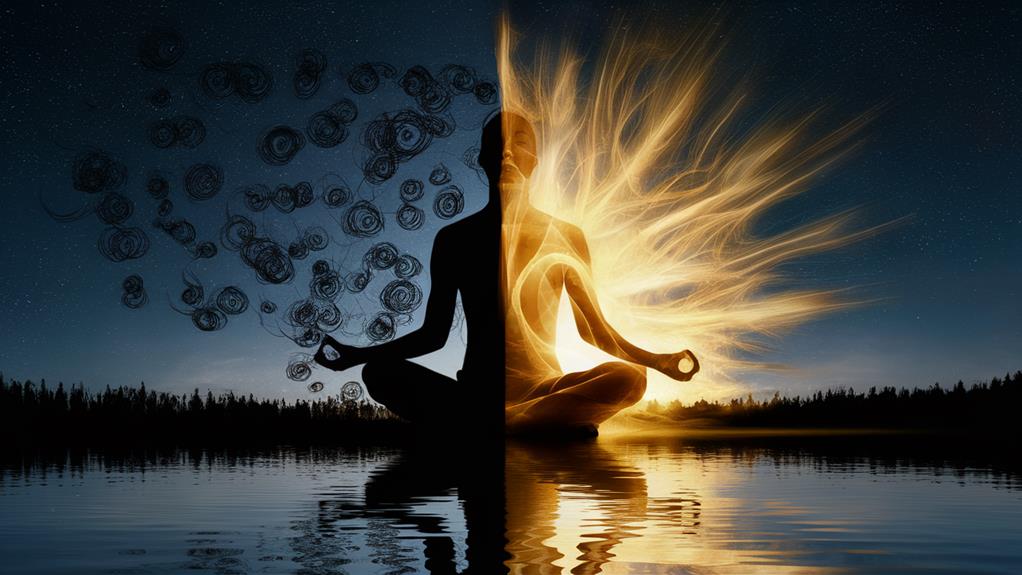
Modern psychology and spiritual traditions offer distinct yet complementary lenses for understanding the Dark Night of the Soul. Through a psychological lens, you’ll recognize this experience as a profound form of existential crisis or depression, where your ego structures begin to dissolve, leading to a deep questioning of your identity and purpose.
You might find yourself maneuvering through what psychologists term as “positive disintegration” – a necessary breakdown that precedes breakthrough.
From a spiritual perspective, you’re encountering what mystics describe as divine intervention, where your soul is being stripped of attachments and illusions. This view suggests you’re not experiencing a pathology to be cured, but rather a sacred process of transformation.
While psychology might encourage you to work through this period with therapy and self-reflection, spiritual traditions invite you to surrender to it as a purifying fire.
You’ll notice how these perspectives, though seemingly at odds, can work together – psychology offering practical tools for maneuvering, while spirituality provides the deeper meaning framework.
In both cases, you’re being called to face your shadows and emerge transformed, whether you view this as psychological integration or spiritual awakening.
Cross-Cultural Mystical Parallels
Across diverse spiritual traditions worldwide, mystical experiences remarkably mirror the Dark Night of the Soul concept.
You’ll find striking parallels between St. John of the Cross’s Christian description and Buddhism’s concept of the “great doubt,” where practitioners confront profound emptiness and spiritual desolation. In Sufism, you’ll encounter the state of “qabd,” a spiritual constriction that mirrors this same transformative darkness.
What you’re witnessing in these parallel experiences isn’t mere coincidence. Whether you’re exploring Hindu teachings about “the cloud of unknowing” or Indigenous wisdom traditions’ vision quests, you’ll discover a universal pattern of spiritual transformation through darkness.
These traditions suggest that you must traverse through periods of intense isolation, doubt, and spiritual aridity to reach deeper spiritual awakening. You’ll notice how each culture’s mystics describe this journey using their own symbolic language, yet they’re pointing to the same profound human experience.
The darkness you might encounter isn’t just an obstacle – it’s a gateway that’s woven into the very fabric of spiritual evolution, transcending cultural and religious boundaries while leading toward a universal truth.
Modern Interpretations and Applications
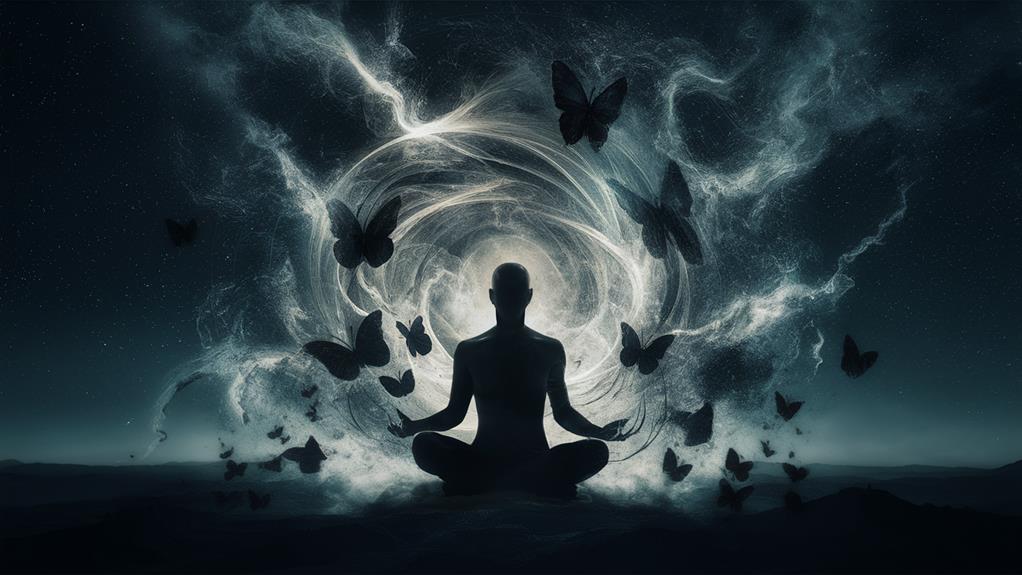
While traditional mystical teachings remain relevant, contemporary interpretations of the Dark Night of the Soul have expanded beyond purely religious contexts. You’ll find this profound concept now applied in psychology, personal development, and even organizational change theory.
Modern therapists and counselors often recognize periods of intense psychological struggle as transformative dark nights that can lead to deeper self-awareness and emotional maturity.
You’re living in an era where this ancient wisdom resonates with secular experiences of depression, burnout, and existential crisis. Whether you’re steering through career changes, relationship endings, or identity shifts, you’ll discover that the dark night framework offers a meaningful context for understanding your journey.
It’s particularly relevant in today’s fast-paced world, where you might find yourself stripped of former certainties and forced to confront fundamental questions about purpose and meaning.
The concept has also found its way into contemporary approaches to trauma healing, where you’re encouraged to view your darkest moments not as permanent states but as passages toward profound personal evolution.
You’ll recognize that these modern applications honor the original mystical insights while making them accessible to today’s seekers.
Healing Through Darkness
The path through darkness holds profound healing potential, even when it feels most overwhelming. As you navigate these shadowed depths, you’ll discover that the very pain threatening to break you open can become the catalyst for your deepest transformation.
Within this sacred darkness, you’re invited to shed what no longer serves you, allowing old wounds to surface and ancient grief to finally find its voice.
You’ll find that darkness itself becomes your teacher, showing you parts of yourself you’ve never dared to face. Through this confrontation with your own depths, you’re learning to embrace uncertainty and find strength in vulnerability.
The process isn’t just about enduring; it’s about allowing darkness to reshape your understanding of wholeness. As you surrender to this journey, you’ll notice that healing often comes not from fighting the darkness, but from learning to rest within it.
Your wounds become doorways to wisdom, your struggles transform into stepping stones, and what once felt like an endless night reveals itself as the prelude to a profound awakening.
In this sacred space of shadow work, you’re not just healing—you’re being remade.
Beyond the Dark Night
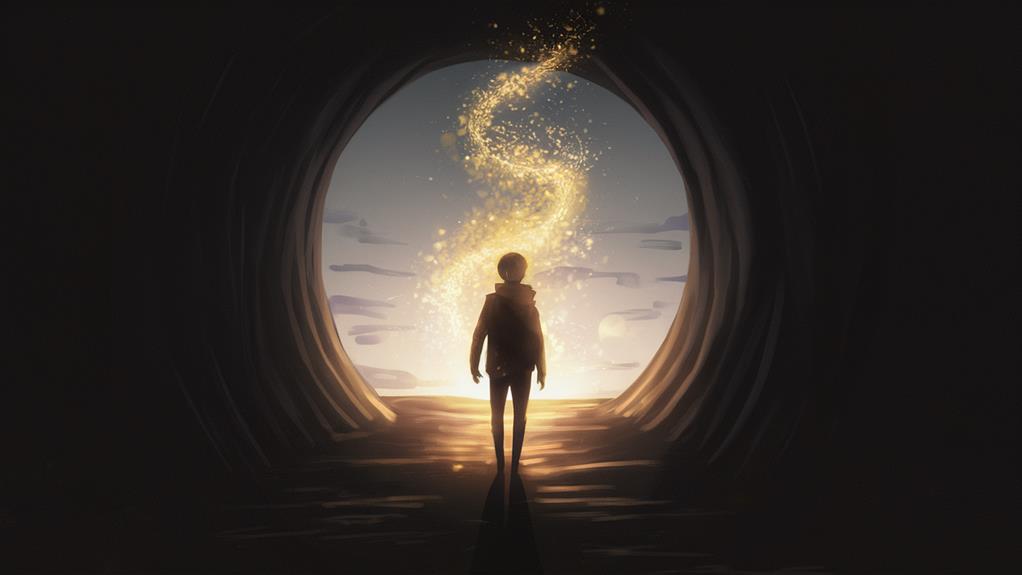
After enduring the dark night of the soul, mystics emerge into a profound state of spiritual clarity and renewed connection with the divine.
You’ll discover that this emergence isn’t merely an ending but a transformation into a more authentic version of yourself, where your spiritual understanding has deepened beyond measure.
In this awakened state, you’ll find that what once felt like insurmountable darkness has become your greatest teacher.
The wisdom you’ve gained through your struggles now illuminates your path forward, allowing you to navigate life’s challenges with newfound grace and understanding.
You’re no longer seeking answers outside yourself, as you’ve learned to trust the inner knowing that’s been strengthened through your journey.
The landscape beyond the dark night reveals itself as a domain of profound peace, where you’ve transcended the dualities that once caused such suffering.
You’ll notice that your relationship with the divine has evolved from desperate seeking to intimate knowing.
This isn’t a final destination but rather a new beginning, where you’re equipped to embrace life’s mysteries with an open heart and seasoned spirit.



